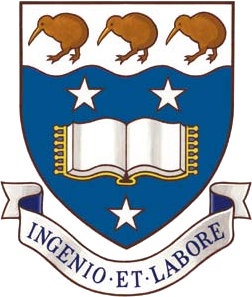
The University of Auckland (UoA) is a public research university based in Auckland, New Zealand. It is the largest, most comprehensive and highest-ranked university in New Zealand and consistently places among the top 100 universities in the QS World University Rankings. The institution was established in 1883 as a constituent college of the University of New Zealand. Originally it was housed in a disused courthouse. Today, the University of Auckland is New Zealand's largest university by enrolment, hosting about 40,000 students on five Auckland campuses. The City Campus, in the Auckland CBD, has the bulk of the students and faculties. There are eight faculties, including a law school, as well as three associated research institutes.
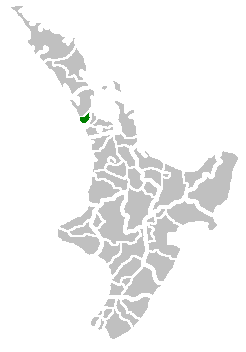
Waitākere City was a territorial authority in West Auckland, New Zealand; it was governed by the Waitākere City Council from 1989 to 2010. It was New Zealand's fifth-largest city, with an annual growth of about 2%. In 2010 the council was amalgamated with the other authorities of the Auckland Region to form the current Auckland Council.

Skycity Auckland is an entertainment complex and casino in the central business district of Auckland, New Zealand, between Victoria and Federal Streets. Located at the base of the Sky Tower, it was the second casino in New Zealand, and is the only casino in Auckland.

Avondale railway station is on the Western Line of the Auckland railway network. Relocated in 2008, the station can be accessed from St Jude St, Layard St, and Crayford St.

Kiwitea Street, also known as Freyberg Field, is a multi-purpose stadium in the suburb of Sandringham in Auckland, New Zealand. It is used for Association football matches and is the home stadium of both Auckland City FC and Central United. Terraced seating can accommodate 250 patrons.

Eliza Ellen Melville was a New Zealand lawyer and politician. She was New Zealand's second female lawyer, and the first woman elected to a city council in New Zealand. She sat on the Auckland City Council for 33 years and was tireless in her work for women's organisations and causes, including in particular the National Council of Women of New Zealand. She believed in the importance of women participating fully and equally in public life, and was a key figure in the revival of the feminist movement in New Zealand after women's suffrage. She was one of the first women to stand for Parliament in New Zealand and ultimately stood (unsuccessfully) seven times.
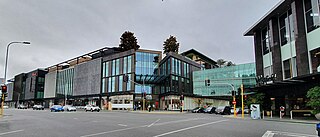
Westfield Newmarket is a shopping centre in Newmarket, a central suburb of Auckland, New Zealand. The centre initially opened in the 1980s; in early 2018, the centre closed for a major re-build and expansion; it re-opened in August 2019 after an 18 month closure. The centre is located at 277 Broadway and, since expansion, 309 Broadway; it was often referred to simply as 277 prior to refurbishment.

Auckland City Hospital is a public hospital located in Grafton, Auckland, New Zealand. It is the largest hospital in New Zealand, as well as one of the oldest medical facilities in the country. It provides a total of 1,165 beds. It was established in 2003 as an amalgam of Auckland Hospital, Starship Hospital, Greenlane Hospital and National Women's Hospital. Public hospitals in Auckland have been run by Te Whatu Ora – Health New Zealand since 2022.

New Zealand society is generally accepting of lesbian, gay, bisexual and transgender (LGBT) peoples. The LGBT-friendly environment is epitomised by the fact that there are several members of Parliament who belong to the LGBT community, LGBT rights are protected by the Human Rights Act, and same-sex couples are able to marry as of 2013. Sex between men was decriminalised in 1986. New Zealand has an active LGBT community, with well-attended annual gay pride festivals in most cities.

Women's suffrage in New Zealand was an important political issue in the late nineteenth century. In early colonial New Zealand, as in European societies, women were excluded from any involvement in politics. Public opinion began to change in the latter half of the nineteenth century and after years of effort by women's suffrage campaigners, led by Kate Sheppard, New Zealand became the first nation in the world in which all women had the right to vote in parliamentary elections.

The Aotea Centre is a performing arts and events centre in Auckland, New Zealand. Located at the western edge of Aotea Square, off Queen Street, the centre provides a cultural, entertainment and conventions venue space in the heart of the city, and is managed by Auckland Unlimited. The origin of its name is Motu Aotea, the Māori name for Great Barrier Island, which is the largest offshore island of New Zealand and approximately 90 km from downtown Auckland.
Grey Lynn is a former New Zealand parliamentary electorate, in the city of Auckland. It existed from 1902 to 1978, and was represented by nine Members of Parliament.
The National Council of Women of New Zealand was established in 1896, three years after women in New Zealand won the right to the vote, as an umbrella organisation uniting a number of different women's societies that existed in New Zealand at that time. Its founding president was Kate Sheppard, who had led the campaign for women's suffrage. The NCWNZ went into recess in 1906 but was reformed in 1919. As of 2021, the NCWNZ remains a leading and influential organisation that works to achieve gender equality in New Zealand. Since 1896, members have agreed resolutions by majority vote at national conferences, which form policies for the NCWNZ's work. These resolutions inform submissions made by the NCWNZ to Parliament, government departments and other organisations.

Rosetta Lulah Baume was an American-born New Zealand teacher, feminist and community leader. She sat on a number of educational boards and in 1919 was one of the first three female candidates for Parliament in New Zealand.

Waikumete Cemetery, originally Waikomiti Cemetery, is New Zealand's largest cemetery. It occupies a site of 108 hectares in Glen Eden, Auckland, and also contains a crematorium in the south-west corner of the cemetery.
Elizabeth Cecilia Wark was a New Zealand social worker and politician.
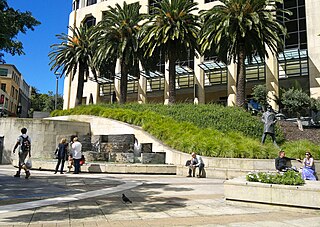
Freyberg Place is a small town square located in Auckland, New Zealand. It is named after Baron Freyberg who was a prominent soldier and the first New Zealand-raised Governor-General of New Zealand.

The Faculty of Education and Social Work is the educational faculty of the University of Auckland. It was created in September 2004 through the merger of the University of Auckland and the Auckland College of Education. Since 2018, the Faculty has been headed by Dean Mark Barrow.
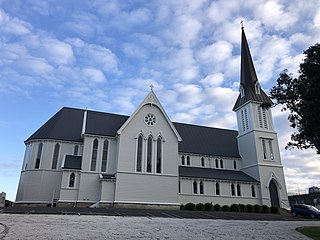
The Church of the Holy Sepulchre is an historic church near the CBD of Auckland, New Zealand. It has played an important role in the history and development of the Anglican denomination in Auckland, being first a central parish church, then the home of the Māori Anglican Mission. Its separate hall was originally the temporary home for St Paul's Church and is now Tātai Hono marae. When the church was constructed, it had the tallest steeple in Auckland, and retains aesthetic qualities as well as being a major landmark. The church has ongoing strong spiritual, cultural and social values, and welcomes all people in a Tikanga Māori Anglican setting.

Shortland Street was the initial commercial street of Auckland and remains a key financial and legal centre for Auckland city. It runs east from Queen Street up to Princes Street, providing a connection from the business district to the Auckland High Court and University of Auckland.

















